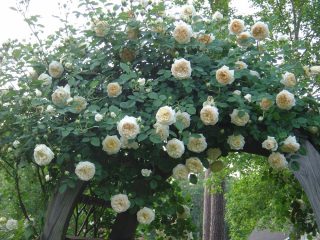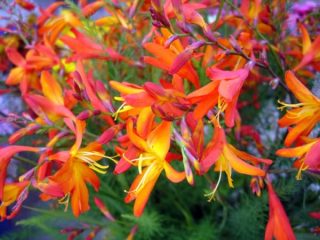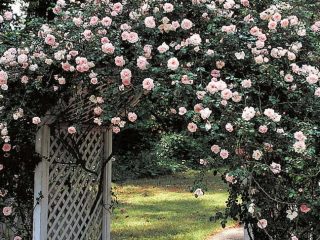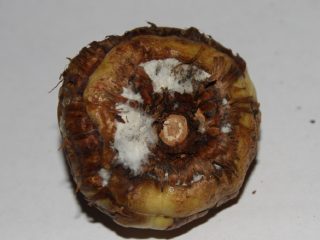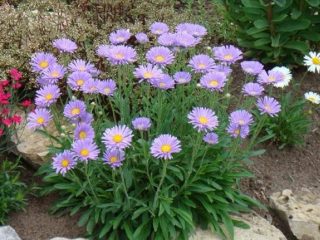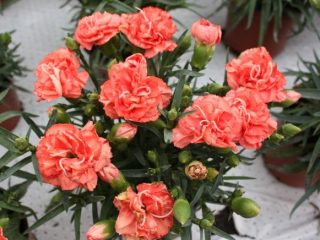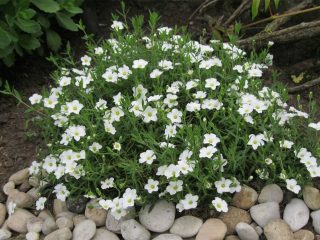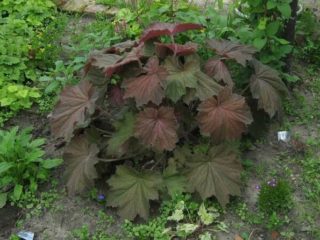Content
Clary sage (lat. Salvia sclarea) is a perennial plant that is a representative of the genus of the same name and the family Lamiaceae. Under natural conditions, it is distributed in Central and Southern Europe, Western and Central Asia, and the Caucasus. However, clary sage is cultivated in many countries around the world. It is valued for its pleasant aroma, therefore it is widely used in cooking and the food industry, and the culture has a rich chemical composition, therefore it is used in medicine. It is in demand as an ornamental plant, so many gardeners prefer to grow it in their garden.

This type of sage has long been used as a flavor enhancer for Muscat wine.
Description of clary sage
This is a herbaceous plant with straight-growing shoots 80-120 cm high. The root is tap-type, highly branched, with a depth of up to 2 m, which allows the nutmeg plant to withstand even prolonged drought.The stems are tetrahedral, in the upper part each of them ends in a large inflorescence.
The leaves below are large, collected at the base of the plant in a rosette, 15-25 cm long and 7-15 cm wide. They have an oval-heart-shaped shape, a wrinkled surface, and long petioles. The upper leaves are much smaller, petiolate, sessile, located oppositely on the shoots. The plates of the muscat variety are hard to the touch, gnawed-toothed along the edge, and dark green in color.

The shoots and leaves of the plant are covered with thick pubescence
The inflorescence is apical, paniculate-branched, and is a false raceme. 2-6 buds are formed in the axils of the bracts. Sage flowers are bisexual, pinkish-violet in color. The upper lip of the corolla is sickle-shaped, the lower lip is obovate, and the lateral lobes are twisted and oblong.
The fruit-nuts are ellipsoidal, up to 2-3 mm in size. When ripe, which occurs in August or September, they become brown, and their surface becomes net-wrinkled. The plant is characterized by extended flowering, which begins in June and continues until September.

The plant is cross-pollinating
What does clary sage smell like?
The culture is distinguished by a high content of essential oils, which is responsible for the pronounced aroma emitted by all parts of the plant. The smell of nutmeg is multifaceted. It combines notes of amber, bergamot and orange.
The benefits and harms of clary sage
The plant is widely used for the prevention and treatment of many diseases. The healing effect of sage is due to its rich chemical composition.It includes organic acids, vitamins P and PP, flavonoids, tannins, resins, bitterness, phytoncides, and in the roots - coumarins. The aerial part of the plant contains essential oil. It has a whole complex of terpene compounds, the leading role among which is linalyl acetate.
The plant has anti-inflammatory, soothing and antioxidant properties. Moreover, the nutmeg variety has a delicate effect on the human body like some types of mint and is not addictive.
However, despite its beneficial properties, in some cases it can be harmful to health. This occurs in case of individual intolerance to the components included in its composition, as well as in case of its excessive use.
Contraindications for clary sage:
- age up to two years;
- epilepsy;
- hypotension;
- thyroid dysfunction;
- tumors;
- bronchial asthma;
- increased levels of estrogen in the blood;
- chronic diseases of the genitourinary system.
Uses of clary sage leaves and flowers
This culture is widely used in traditional medicine. The effectiveness of sage flowers and leaves for coughs, atherosclerosis, Parkinson's disease, sore throat, colds, and nervous disorders has been proven.

Clary sage accelerates the body's recovery after a stroke, coronavirus, and reduces blood stagnation
It is prescribed to women in combination with hormonal drugs, as well as to men to increase testosterone levels.Sexologists and urologists believe that regular use of clary sage decoctions in measured quantities helps increase sexual desire and improve sperm mobility, which promotes conception.
The plant is also used in folk medicine. Decoctions, infusions, and tea are prepared using sage. These drugs are used to treat the genitourinary system and prostatitis. Clary sage also helps with painful menstruation. To reduce unpleasant symptoms, it is recommended to take the tincture.
The herb is also effective for excessive sweating. Moreover, its effect is felt almost immediately after drinking a cup of tea, and the maximum result is achieved after two hours and can sometimes persist for 24 hours. Therefore, the drink is recommended for people with tuberculosis.
This medicinal herb is also used externally. It is used to prepare rubs, ointments, and lotions. Tannins present in clary sage have a beneficial effect on the skin. They prevent clogging of pores, the appearance of blackheads, and reduce inflammation in dermatitis. Clary sage is also good for hair, as it strengthens hair follicles and prevents baldness. Therefore, the plant extract is included in many strengthening shampoos.
The shrub is also in demand in cooking as a seasoning. Its leaves and flowers are added to meat and fish dishes, pizza, sausage, and pasta.
Clary sage is also used in perfumery, although its aroma is considered complex. Therefore, perfumes are made based on it, not combined with other odors, since it completely displaces them.
Advantages and disadvantages
This type of sage has many advantages, so it is used in many areas.However, this plant also has certain disadvantages that are worth paying attention to. After all, only knowing for sure what the benefits and harms of clary sage are for men and women can use the plant without fear for their health.

Dried medicinal herbs can be stored for up to two years.
Advantages:
- has medicinal properties;
- has a gentle effect on the body;
- characterized by a multifaceted aroma;
- effective for the treatment and prevention of diseases;
- is highly decorative;
- has a wide range of applications.
Flaws:
- when combined with other aromas, it completely suppresses them;
- has a number of contraindications;
- is an allergen;
- unable to eliminate chronic diseases.
Growing clary sage in the country
The agricultural technology for growing clary sage is no more difficult than any other garden crop. However, in order for the plant to please with abundant flowering and be able to accumulate the maximum amount of useful components in the leaves and flowers, it is recommended to take into account the basic requirements of the crop.
Clary sage seedlings
To obtain strong seedlings of clary sage at the beginning of the season, it is recommended to use the seedling growing method. To do this, it is necessary to sow the plant at the end of February or early March at home. Dates may change depending on the climate of the region.
For planting, you will need to prepare a cassette with a cell size of 2 by 2 cm, as well as nutrient soil consisting of turf, humus, peat and sand, taken in equal quantities. The substrate must first be shed with a solution of potassium permanganate and then dried until characteristic flowability appears.
Procedure:
- Fill the cassette with soil and water it. After absorbing moisture, make small indentations in the center of each cell.
- Place the seeds in them and sprinkle with a 0.3-0.5 cm layer of soil. Re-moisten the surface of the substrate with a spray bottle.
- Cover the cassette with a transparent lid and move it to a dark place with a temperature of +25 °C.
To successfully grow clary sage from seeds, the mini-greenhouse needs to be ventilated daily for 15-25 minutes and any accumulated condensation removed from the lid. If all recommendations are followed, the first sprouts of clary sage appear on the 7-10th day. After this, the cassette must be transferred to a bright window sill and the maintenance regime must be lowered to +23 °C, and also provided with at least 10-12 hours of daylight.
When the seedlings grow up and become stronger, they need to be adapted to external conditions. To do this, you need to open the seedlings completely every day, constantly increasing the time interval. After a week, the lid can be completely removed from the seedlings.
At the stage of the appearance of two true leaves, the seedlings need to be planted in separate cups with a volume of 200 ml. They must have drainage holes. The same soil can be used as when sowing seeds. During the procedure, plants must be grasped by the leaves, as they have a fragile stem.
A week after picking, the seedlings need to be fed with Kemira Lux. And when the seedlings grow three pairs of leaves, it is recommended to pinch the plant, which will enhance the growth of side shoots. It is necessary to water the seedlings moderately.

Sage seedlings are afraid of drafts and temperature changes
Planting in open ground
It is recommended to transfer seedlings to open ground at the end of May, when the soil has warmed up well to a depth of 10 cm and the threat of return frosts has passed. But before this, the plants need to be hardened off. Therefore, initially you need to take the seedlings outside for half an hour and keep them in a shaded place, and with each subsequent day increase the time period by 30 minutes. After 7-10 days, clary sage seedlings can be planted in a permanent place.
For planting, you need to prepare holes at a distance of 25-30 cm. Their size should be slightly larger than the earthen clod of the plant. It is recommended to add a little humus and a handful of wood ash to each hole. When planting, seedlings do not need to be buried. Their root collar should be at soil level. At the end of the procedure, water the bed generously and cover it with agrofibre for two days.
Rules of care
Caring for the crop involves watering as the top layer of soil dries to a depth of 3-5 cm. To do this, you can use settled water at a temperature of +23 °C. Moistening is carried out in the evening at the root of the grass. After each watering, it is necessary to loosen the soil to maintain air access to the roots of the plant. In addition, it is recommended to weed young seedlings in a timely manner. In the future, when the plant grows and becomes stronger, it will be able to independently suppress the growth of weeds.
Sage does not need regular feeding. It is enough to fertilize the plant no more than twice per season.It is recommended to fertilize for the first time at the beginning of the growing season, using urea at the rate of 30 g per adult bush. The second time you need to fertilize sage is at the end of June or at the beginning of July. At this time, you need to use superphosphate 30 g and potassium sulfide 20 g per plant.

Sprinkle fertilizers into the root circle after rain or watering and then incorporate them into the soil
The plant may suffer from an invasion of pests such as weevils, spider mites, and cutworms. In this case, it slows down development, the inflorescences and leaves dry out prematurely, and the overall appearance becomes depressing.

If signs of damage appear, it is necessary to spray the plant with Fitoverm, Fufanon or Zenkor
Clary sage also suffers from fungal diseases: powdery mildew, leaf spot. Therefore, it is recommended to spray the grass with Bordeaux mixture in the spring, and also in the summer when signs of damage appear.

Planting clary sage in its original place can be done no earlier than five years later.
Propagation of clary sage
The plant propagates by seeds and division of the bush. In the first case, planting in open ground should be carried out in May, when the ground has warmed up well. The recommended sowing depth for sage is 1 cm. After this, the bed must be well watered and covered with agrofibre. When growing clary sage from seed, the main thing is to water the seedlings in a timely manner and weed out weeds. With this growing method, the plant blooms in the second year after planting.
It is recommended to divide the bushes of the crop in the spring after the beginning of the growing season.To do this, you need to dig up the mother sage plant and use pruning shears to cut it into pieces, each of which should have a growing point and well-developed roots. After this, the divisions must be immediately planted in a permanent place. Water thoroughly and lightly shade for several days.

Planting clary sage in its original place can be done no earlier than five years later.
Clary sage in landscape design
The plant is characterized by high decorative value. The clary sage variety looks impressive in a large clump against the backdrop of a green lawn. Tall varieties of subshrubs are great for the background of mixborders and flower beds.

When choosing companions for sage, it is necessary to select plants with a different type of inflorescence so that the crops can successfully complement each other
Clary sage goes well with:
- decorative cereals;
- different types of irises;
- geraniums;
- daylilies;
- dahlias;
- window sill.
Conclusion
Clary sage is one of the plants that will not cause much trouble to the gardener, but will look appropriate as a tapeworm, as well as in combination with other garden crops. By growing it in a personal plot, you can get not only a decorative element, but also medicinal raw materials and seasoning.
Reviews about clary sage



